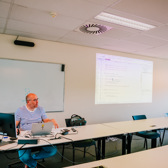Power Platform ALM and Governance Strategies
UPPG
3 days
Interested in a private company training? Request it here.
Working with Environments in the Power Platform
This chapter introduces how Environments can used to separate your development, acceptance and production environment. It also explains how you configure environment security so that only approved users can create and manage environments.
- Overview of the Power Platform
- The Role of Environments in the Power Platform
- Creating and Managing Environments
- Environments and Security
- The Default Environment
- LAB: Creating Environments
Working with Solutions in the Power Platform
Solutions are used by app makers and developers to package related customizations together so that they can be managed and deployed as a single unit. We will see what components can be added to a solution and how they are essentially the building blocks of your environment.
- Working with Solutions in Environments
- Default Solutions in an Environment
- Creating Solutions and Solution Publishers
- Creating Canvas Apps and Power Automate Flows inside a Solution
- Importing and Exporting Solutions
- Managed versus Unmanaged Solutions
- Solutions and Managed Properties
Working with Connection References and Environment Variables
In this chapter you will learn about Connection References and Environment Variables and how they can be used to solve the issue of connecting to separate development/acceptance/production data sources without having to make major changes in a Power Automate Flow or Canvas App.
- Introducing Connection References
- Connection References in Power Automate Cloud Flows
- Connection References in Canvas Apps
- Manually Creating Connection References in Solutions
- Importing Solutions with Connection References
- Connection References Gotchas
- LAB: Working with Connection References and Environment Variables
Application Lifecycle Management (ALM) with the Microsoft Power Platform CLI
When developing larger apps and flows it is important to separate your development, acceptance and production environments. In this chapter your will learn how to implement ALM in the Power Platform CLI. You will also see how to unpack Canvas Apps into their source code. From the source code you can reassemble your solutions and import them in your acceptance or production environments.
- The Microsoft Power Platform CLI
- Application Lifecycle Management with the Power Platform CLI
- Editing a Canvas App using Power FX and Visual Studio Code
- Managing Environment Variables and Connection References with the Power Platform CLI
- LAB: Automate ALM with Power Platform CLI Scripts
Working with Service Principals in the Power Platform
You do not want your business critical apps and flows to be owned by personal Microsoft 365 account. Likewise, when using the Power Platform CLI to create Deployment Pipelines, you do not want to run them with your Microsoft 365 account. In this chapter you will learn how create and use Service Principals to own and deploy Power Platform artifacts.
- Which artifacts are actually user-owned?
- What are Service Principals?
- Creating and Configuring a Microsoft Entra ID Application Registration
- Using Service Principals in Canvas Apps and Power Automate Flows
- Working with Service Principals in the Power Platform CLI
- LAB: Configure and Use Service Principals for better ALM Practices
Working with Pipelines in the Power Platform
Pipelines in the Power Platform aim to democratize application lifecycle management (ALM) for Power Platform and Dynamics 365 customers. They bring ALM automation into the service in a manner that's more approachable for all makers, admins, and developers.
- What are Pipelines?
- Setup Pipelines
- Run Pipelines
- Extend Pipelines
- Personal Pipelines
- LAB: Configuring Pipelines with Service Principals
Working with On-Premises Data Sources
Companies don't move with all their data to the cloud. What if you want to build Canvas Apps or Power Automate Flows that access on-premises data sources? This requires that you install and configure a so-called Data Gateway.
- Online vs. On-Premises Data Sources
- Installing and Configuring a Data Gateways
- Using a Data Gateways in Canvas Apps and Power Automate
- LAB: Accessing On-Premises Data Sources using a Data Gateway
Working with the Center of Excellence Toolkit
The Microsoft Power Platform CoE Starter Kit is a collection of components and tools that are designed to help you get started with developing a strategy for adopting and supporting the Microsoft Power Platform. In this chapter you will learn how to install and configure the Center of Excellence Toolkit and how it can be used to make sure your organization is following all best practices for the Power Platform.
- Setup the Center of Excellence Toolkit
- What's in the Center of Excellence Toolkit?
- Using the Center of Excellence Toolkit
ALM is the lifecycle management of applications, which includes governance, development, and maintenance. In this course, you will learn how to use the Power Platform features and tools available to manage ALM. By the end of the course, participants will be equipped with a comprehensive skill set for successful development, deployment, and operation of a Power Platform environment.
This course is targeted at Power Platform makers and administrators who are interested in managing and deploying Power Apps and Flows in a corporate environment. Participants should have a basic understanding of Power Apps and Power Automate.











